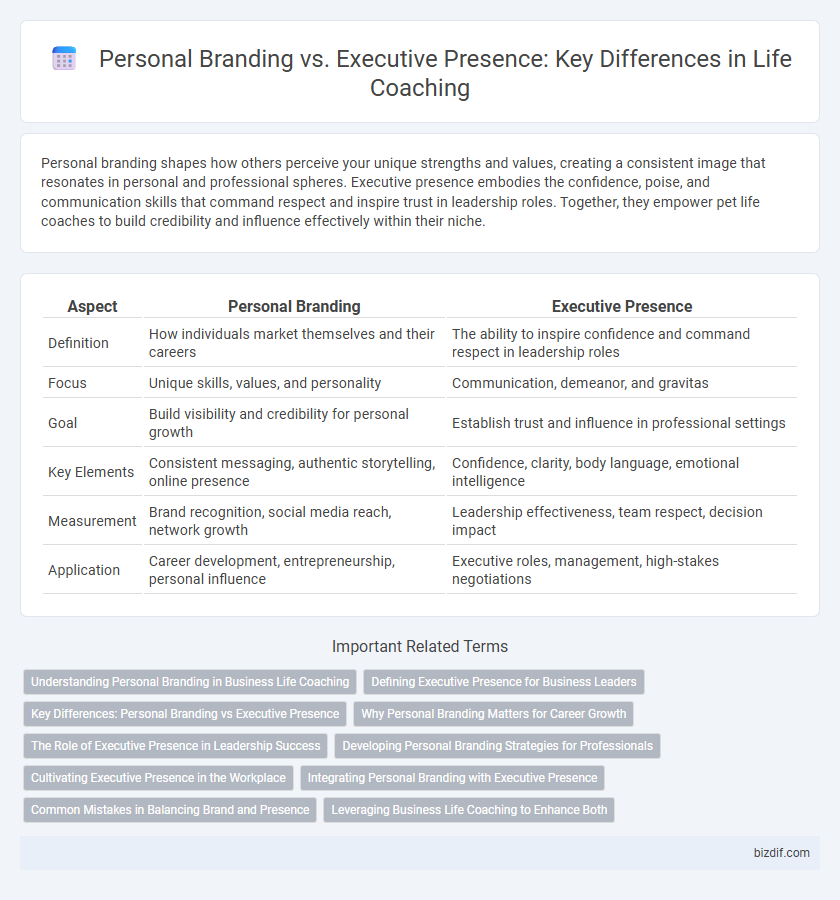Personal branding shapes how others perceive your unique strengths and values, creating a consistent image that resonates in personal and professional spheres. Executive presence embodies the confidence, poise, and communication skills that command respect and inspire trust in leadership roles. Together, they empower pet life coaches to build credibility and influence effectively within their niche.
Table of Comparison
| Aspect | Personal Branding | Executive Presence |
|---|---|---|
| Definition | How individuals market themselves and their careers | The ability to inspire confidence and command respect in leadership roles |
| Focus | Unique skills, values, and personality | Communication, demeanor, and gravitas |
| Goal | Build visibility and credibility for personal growth | Establish trust and influence in professional settings |
| Key Elements | Consistent messaging, authentic storytelling, online presence | Confidence, clarity, body language, emotional intelligence |
| Measurement | Brand recognition, social media reach, network growth | Leadership effectiveness, team respect, decision impact |
| Application | Career development, entrepreneurship, personal influence | Executive roles, management, high-stakes negotiations |
Understanding Personal Branding in Business Life Coaching
Personal branding in business life coaching involves creating a distinct and authentic professional identity that communicates core values, expertise, and unique strengths to target audiences. It emphasizes consistent messaging across digital platforms, networking, and professional interactions to build trust and credibility. Understanding personal branding enhances career growth by positioning individuals as industry leaders and differentiating them in competitive markets.
Defining Executive Presence for Business Leaders
Executive presence for business leaders is defined by a combination of confidence, effective communication, and the ability to inspire trust and respect within an organization. It encompasses poise under pressure, clarity in decision-making, and the capacity to influence and motivate teams toward strategic goals. Unlike personal branding, which centers on an individual's unique identity and reputation, executive presence is demonstrated through leadership behaviors that drive organizational success.
Key Differences: Personal Branding vs Executive Presence
Personal branding centers on crafting and communicating a distinctive professional identity that highlights individual values, skills, and unique selling points, shaping how others perceive you across platforms. Executive presence encompasses behaviors, communication style, and emotional intelligence that inspire confidence and command respect in leadership contexts, influencing how leaders are perceived in high-stakes environments. Key differences lie in personal branding's focus on self-promotion and external image, while executive presence emphasizes interpersonal impact and leadership gravitas within organizational settings.
Why Personal Branding Matters for Career Growth
Personal branding establishes a distinct professional identity that differentiates individuals in competitive job markets and attracts opportunities aligned with their strengths and values. Executive presence complements this by projecting confidence and leadership, but personal branding drives long-term career growth through consistent messaging and authentic storytelling. Investing in personal branding builds trust and recognition, crucial for networking, promotions, and sustained success in any industry.
The Role of Executive Presence in Leadership Success
Executive presence plays a critical role in leadership success by projecting confidence, decisiveness, and authenticity that inspire trust and influence within teams and organizations. Unlike personal branding, which focuses on how individuals market themselves to create a distinct professional identity, executive presence emphasizes behavior, communication style, and emotional intelligence to establish authority and credibility. Leaders with strong executive presence drive organizational performance through effective decision-making, strategic vision, and the ability to engage and motivate stakeholders.
Developing Personal Branding Strategies for Professionals
Developing personal branding strategies for professionals involves identifying core values, unique skills, and consistent messaging that align with career goals. Effective personal branding enhances visibility and credibility, distinguishing individuals in competitive markets. Integrating storytelling and digital presence strengthens connections with target audiences, driving professional growth.
Cultivating Executive Presence in the Workplace
Cultivating executive presence in the workplace involves mastering communication, demonstrating confidence, and exhibiting emotional intelligence to inspire trust and influence decisions effectively. Unlike personal branding, which centers on crafting a unique identity and reputation, executive presence emphasizes the ability to lead with authenticity and command respect in high-stakes environments. Developing executive presence enhances leadership impact, critical for career advancement and organizational success.
Integrating Personal Branding with Executive Presence
Integrating personal branding with executive presence amplifies a leader's influence by aligning authentic values with impactful communication and behavior. Effective life coaching helps clients craft a consistent personal brand that resonates with their executive presence, enhancing credibility and trust across professional interactions. This seamless integration drives career advancement and inspires teams through a powerful, cohesive leadership identity.
Common Mistakes in Balancing Brand and Presence
Common mistakes in balancing personal branding and executive presence include overemphasizing self-promotion while neglecting authentic leadership qualities that build trust. Professionals often confuse flashy branding with genuine influence, leading to a disconnect between projected image and actual impact. Effective life coaching addresses these pitfalls by aligning personal values with visible behaviors to create a cohesive, credible professional persona.
Leveraging Business Life Coaching to Enhance Both
Business life coaching strategically enhances personal branding by refining authentic communication and clarifying unique value propositions, while simultaneously cultivating executive presence through improved confidence, decision-making, and leadership skills. Integrating targeted coaching techniques enables professionals to project a compelling image and authoritative demeanor, fostering stronger influence and career advancement. This dual-focus approach transforms personal identity into a powerful business asset, driving sustained professional growth and organizational impact.
Personal Branding vs Executive Presence Infographic

 bizdif.com
bizdif.com